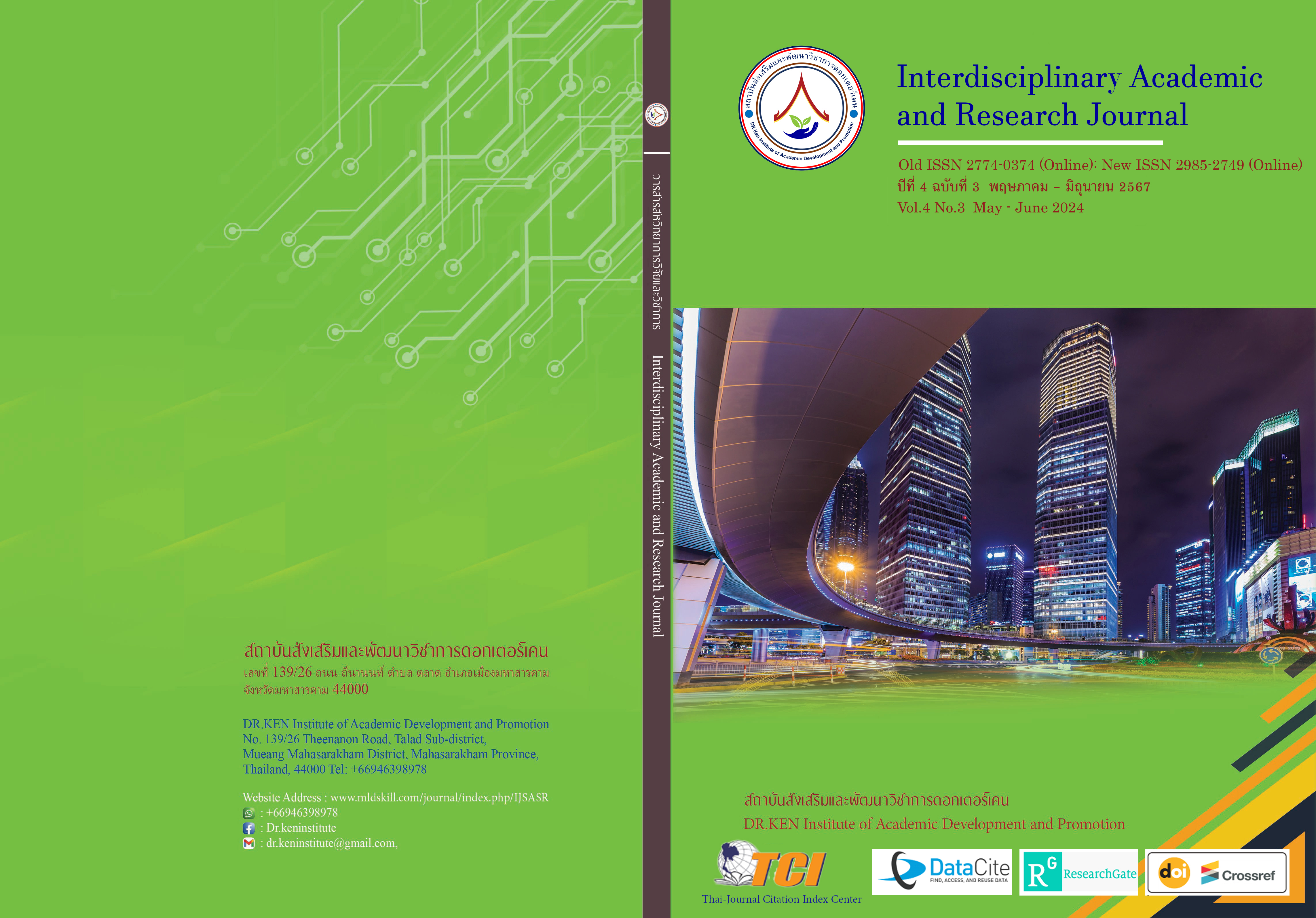The Study of English Speaking Anxiety of Upper Primary School Students Wichutit School
DOI:
https://doi.org/10.60027/iarj.2024.276464Keywords:
English Speaking; , Anxiety ; , Upper Primary SchoolAbstract
Background and Aims: As speaking is one of the fundamental life skills and communication skills, it is a vital communication skill. Speaking English can cause anxiety for a variety of reasons. It is acknowledged that students' speaking expressions are impacted by their speaking anxiety. It's normal to experience anxiety and nervousness when learning a second or foreign language. In this research, the researcher examines (1) the English-speaking anxiety of upper elementary school students at Wichutit School, Din Daeng District Office under the Bangkok Metropolitan Administration; and compares (2) the English-speaking anxiety of the students under study between the students studying in the traditional study plan and those in the English study plan.
Methodology: The sample population consisted of 186 upper elementary school students studying in the academic year 2023 using the stratified sampling technique. The research instruments consisted of a questionnaire eliciting English-speaking anxiety and a thirty-item five-rating scale. Data were analyzed using descriptive statistics of frequency, percentage, mean, and standard deviation. The technique of independent t-test was employed to compare the mean of the two groups of the sample population.
Results: (1) The average overall anxiety score for students following the regular study plan was related to speaking English. (2) The average overall score for English-speaking anxiety among students following the English language study plan is extremely low. And (3) At Wichutit School, there is a notable difference in upper primary school students' anxiety levels when speaking English between those following the regular study plan and the overall English study plan. 05.
Conclusion: When speaking English, students who follow the regular study plan show higher levels of anxiety than those who follow the dedicated English language study plan. This suggests that specialized language education is effective in lowering language-related anxiety among students at Wichutit School.
References
ณัฏฐ์นรี ฤทธิรัตน์ และธัญภา ชิระมณี. (2557). ปัญหาและอุปสรรคในการพัฒนาทักษะการพูดภาษาอังกฤษของนักศึกษาไทย. วิทยานิพนธ์ปริญญามหาบัณฑิต สาขาการสอนภาษาอังกฤษเป็นภาษานานาชาติ:มหาวิทยาลัยสงขลานครินทร์.
เตือนใจ เฉลิมกิจ. (2545). การพัฒนาทักษะการพูดภาษาอังกฤษ โดยใช้หลักการใช้สมองเป็นฐาน ตามหลักการของอิริค เจนเซ่น ชั้นมัธยมศึกษาปีที่ 1. วิทยานิพนธ์คณะศึกษาศาสตร์: มหาวิทยาลัยบูรพา.
ธีราภรณ์ กิจจารักษ์. (2553). ปัจจัยที่ส่งผลต่อการพูดภาษาอังกฤษของนักศึกษาชั้นปีที่ 2 สาขาวิชาภาษาอังกฤษ คณะครุศาสตร์ มหาวิทยาลัยราชภัฏในเขตกรุงเทพมหานคร (รายงานการวิจัย). มหาวิทยาลัยราชภัฏสวนสุนันทา: กรุงเทพฯ.
นิศากร แสงสว่าง. (2557). ผลการใช้สื่อคอมพิวเตอร์ช่วยสอนภาษาอังกฤษที่เน้นนิทานคุณธรรมเพื่อส่งเสริมความสามารถในการอ่านภาษาอังกฤษและความตระหนักรู้ด้านคุณธรรมสำหรับนักเรียนชั้นประถมศึกษาปีที่ 6 โรงเรียนสกลวิทยาอำเภอสามพรานจังหวัดนครปฐม. วิทยานิพนธ์ตามหลักสูตรปริญญาศึกษาศาสตรมหาบัณฑิต. สาขาวิชาการสอนภาษาอังกฤษในฐานะภาษาต่างประเทศภาควิชาหลักสูตรและวิธีสอนมหาวิทยาลัยศิลปากร.
พนิดา ตาสี. (2552). ปัจจัยที่ส่งผลต่อความวิตกกังวลในการพูดภาษาอังกฤษของนักศึกษาเอก ภาษาอังกฤษ (รายงานการวิจัย). มหาวิทยาลัยเทคโนโลยีสุรนารี: นครราชสีมา.
ศิริพร จิรวัฒน์กุล. (2546). การวิจัยเชิงคุณภาพในวิชาชีพการพยาบาล. พิมพ์ครั้งที่ 2. ขอนแก่น : ศิริภัณฑ์ ออฟเซ็ท.
สุมิตรา อังวัฒนกุล. (2540). แนวคิดและเทคนิคการสอนภาษาอังกฤษระดับมัธยมศึกษา. กรุงเทพฯ : โรงพิมพ์จุฬาลงกรณ์มหาวิทยาลัย.
สุวิมล ติรกานันท์. (2551). การสร้างเครืองมือวัดตัวแปรในการวิจัยทางสังคมศาสตร์ : แนวทางสู่การปฏิบัติ. พิมพ์ครั้งที่ 2. กรุงเทพฯ: โรงพิมพ์จุฬาลงกรณ์มหาวิทยาลัย.
อรพรรณ วีระวงศ์. (2554).. งานวิจัย มศว.ระบุเด็กไทยเรียนอังกฤษเพื่อสอบ พูดอ่อนแอมาก แนะศธ.-สทศ. เปลี่ยนข้อสอบภาษาอังกฤษ จะทำให้เด็ก-ครู-โรงเรียนเปลี่ยน ระบุครูเรียนปรับวุฒิ ไม่ได้มุ่งพัฒนาเด็ก อยากเห็นรัฐบาลฟื้นโครงการทุนครู เน้นเด็กดี-เก่งเรียนครู. SWU Weekly. Retieved from: http://ccapp.swu.ac.th.
อรรชนิดา หวานคง. (2559). การจัดการเรียนการสอนภาษาอังกฤษในศตวรรษที่ 21. วารสารสถาบันวิจัยญาณสังวร, 7(2), 304-314. https://so04.tci-thaijo.org/index.php/yri/article/download/184935/130126/.
อารีรักษ์ มีแจ้ง และ สิริพร ปาณาวงษ์. (2553). การพัฒนาหลักสูตรฝึกอบรมครูภาษาอังกฤษโดยใช้ปัญหาเป็นฐาน สำหรับครูผู้สอนช่วงชั้นที่ 2. วารสารศึกษาศาสตร์ มหาวิทยาลัยนเรศวร. 12(2), 17-31.
Aida, Y. (1994). Examination of Horwitz, Horwitz, and Cope's construct of foreign language anxiety: The case of students of Japanese.The Modern Language Journal, 78(2), 155-168. https://doi.org/10.2307/329005.
Byrne, D. (1986). Teaching oral English. London: Longman.
Harris, D. P. (1988). Testing English as a Second Language. New York: McGraw Hill.
Horwitz, E.K. (2001). Language anxiety and achievement. Annual Review of Applied Linguistics, 21, 112-126.http://dx.doi.org/10.1017/S0267190501000071
Horwitz, E.K., Horwitz, M.B., & Cope, J.A. (1986). Foreign language classroom anxiety. The Modern Language Journal, 70(2), 125-132. http://dx.doi.org/10.2307/327317
Little, W. (1998). Communicative Language Teaching. 18th edition. Cambridge: Cambridge University Press.
Nation, P. (2001). Teaching vocabulary in another language. Cambridge: Cambridge University Press.
Panthito, B. (2018). A Study of the Problems of English Speaking Skills of the First Year Students at Mahachulalongkornrajavidyalaya University. Journal of MCU Humanities Review, 4 (2), 185-195.
Scott, R. (1981). Speaking in Communication in the Classroom. Longman Group UK Ltd.
Ur, P. (1998). A Course in Language Teaching Trainee. Cambridge: Cambridge University Press.
Downloads
Published
How to Cite
Issue
Section
License
Copyright (c) 2024 Interdisciplinary Academic and Research Journal

This work is licensed under a Creative Commons Attribution-NonCommercial-NoDerivatives 4.0 International License.
Copyright on any article in the Interdisciplinary Academic and Research Journal is retained by the author(s) under the under the Creative Commons Attribution-NonCommercial-NoDerivatives 4.0 International License. Permission to use text, content, images, etc. of publication. Any user to read, download, copy, distribute, print, search, or link to the full texts of articles, crawl them for indexing, pass them as data to software, or use them for any other lawful purpose. But do not use it for commercial use or with the intent to benefit any business.
















.png)


